Legends of Runeterra is currently offline until November 14, 2019.
Legends of Runeterra is the recently announced card game by Riot Games based on League of Legends characters and lore. The game is planned for release in Q1 of 2020, the rollout plan can be found here. Since the announcement, they have given a number of keys for a patch preview this past week to content creators (like myself) and a lucky few who won the lottery via pre-registration with increased odds for playing League of Legends or watching it streamed on Twitch.
We have a number of articles detailing Runeterra more extensively, but my goal today is to answer this question: What is Runeterra like compared to Hearthstone and why should you care?
I'd like to start by giving you some of my background with Hearthstone. It is the first collectable card game I ever played, I found it on mobile and was instantly hooked by the beautiful graphics, easily accessible gameplay, and playful nature of the cards. I began playing during Blackrock Mountain with a brief hiatus during Pirate Warrior's Reign of Terror (it was 67% of the metagame and consistently won by turn 4). I had a year of play almost exclusively in Arena before getting deeper into Standard Ranked play with the introduction of Death Knights when I hit Legend for the first time. I joined Out of Cards to share the same knowledge the community gave me when I was learning how to play the game. My ties with Hearthstone run deep and I haven't been able to find a suitable replacement up to this point. I played Auto-chess but got bored, I recognized Artifact as an overcomplicated-joke, and Magic has too much history for me to get into; Hearthstone remained king.
That changed when I played Legends of Runeterra. The other night I couldn't put it down, I played until 2:30 am for 6 hours straight. It stands a real chance of becoming my main game and this article details why.
Game Overview
Your goal in Runeterra is the same as in League of Legends: destroy the enemy Nexus. The Nexus is essentially your health pool in Hearthstone. Both players start with 20 health and 40 cards in their deck. There is an attacking phase and a defending phase that you and your opponent alternate each turn. Both players are allowed the same amount of mana and a chance to take the same number of actions each turn. We'll get into more details below.
Deck Building
Let's talk about deck building and how it is different in Runeterra.
Classes vs. Regions






Legends of Runeterra does not have Classes to build your decks around, instead, it has Regions. There are no neutral cards. There are 6 regions with their own card sets and mechanics, you are allowed to combine any two regions to build a deck. In Hearthstone, you can reasonably play around cards based on which class you are up against; but you need to play around the neutral cards as well. Runeterra displays which regions your opponent's deck hails from, allowing for similar play-around. The best comparison for decks in Runeterra is dual-class arena in Hearthstone. Dual-class arena runs every October in Hearthstone, it's the only time of year I always play arena due to the unique deck-building. Deck-building in Runeterra is best related to Hearthstone as building a dual-class deck with only class cards.

The opponent is playing Ionia and Freljord, as seen on the left side of the screen.
By the Numbers
Deck-building limitations:
- Runeterra: 40 cards, 6 Champion limit, 3x of any card (including Champions), 2 Regions
- Hearthstone: 30 cards, 1x Legendaries, 2x any other, 1 Class and Neutrals
How do the differences change my deck-building process?
Statistically speaking, you are much more likely to draw cards that are part of your plan in Runeterra than you are in Hearthstone. In general, the effects of cards in Runeterra is much weaker than in Hearthstone. The impact of individual cards in Hearthstone is and should be much greater due to Legendaries being 1x in every deck. This tradeoff of more consistency for less power in each card feels fair to me. In Hearthstone I am often waiting for the 1 card in my deck that will win me the game. In Runeterra my deck accomplishes what it was built to do almost every game, whether I win or lose.
Champions
Hearthstone has minions, Runeterra calls them units. Runeterra has two distinctions for units: followers and champions. Champions are your Legendary cards from Hearthstone, the most impactful ones in the game. You can combine any 6 champions from 2 regions in any deck. Champions are the most powerful cards in the game and are typically the build-around cards for your decks. Each champion functions much like quests from Hearthstone. Champions have the ability to level-up once their conditions are met, these leveled-up champions often result in winning the game.
Upon leveling, they'll turn into...
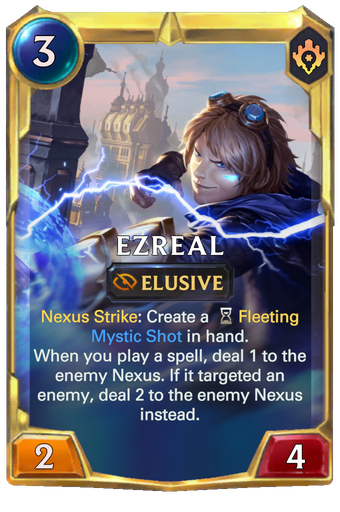
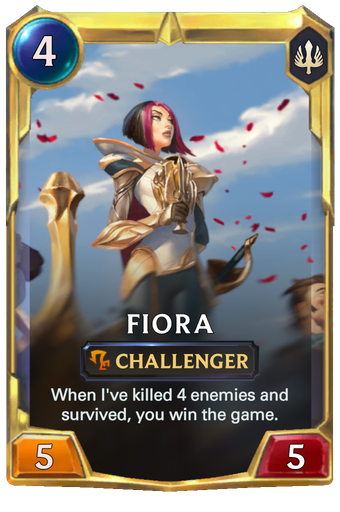
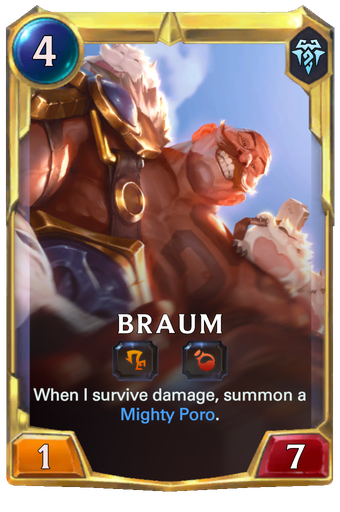
Note the new borders, higher stats, and no more level-up condition.
There are 24 Champions planned for the game's release, with each region getting 4 Champions. You can see them all here.
Followers
Followers are your Common, Rare, and Epic minions from Hearthstone. You can have up to 3 of any of them in your deck. Followers have a variety of keywords on them and they vary quite a bit depending on how you want to build your deck. They are region-specific and many of them form the essential body of the deck around the Champions. Some have interactions with specific Champions and others simply have powerful abilities.
See them all here and check out these examples:
Green, Blue, and Purple - the same as Hearthstone rarities!
Spells
Spells are an essential part of the game, just like in Hearthstone, but the effects are weaker for their cost. The key difference is that spells have a speed associated with their cost. There are 3 speeds: Burst, Fast, and Slow. Burst spells are instant and can be used at any point in during one of your actions for an immediate effect, your opponent is not allowed a reaction. Burst spells are essentially cantrips (if you are familiar with this D&D term): relatively weak, but effective. Fast spells can be used during one of your actions, your opponent can also play a fast spell in reaction. A slow spell takes up an entire action and will allow your opponent to play any type of spell or a unit in response. Spells play a huge role in how combat plays out. Learning how to utilize and manipulate spells will be a huge part of the learning curve.
See them all here and check out these examples:
Keyword Glossary
Just like in Hearthstone, Runeterra has it's own set of keywords. A few of these have direct correlations with Hearthstone, those are:
- Last Breath = Deathrattle
- Barrier = 1-turn Divine Shield
- Lifesteal
Others do not. Here are the list and definitions: Keywords.
What does a turn look like?
Every action you take in Runeterra gives your opponent the opportunity for a reaction. Hearthstone presents the player with a static board to make decisions, Runeterra only gives you the choice to make one decision at a time before the opponent can respond as they wish. Runeterra gives the defender initiative to initiate trades rather than the attacker, thus improving the ability to make meaningful decisions at each stage of the game. If you play a unit (think minion), your opponent will also get to play a unit or play a Slow spell.
Runeterra has two turn phases: Attacking - indicated by the Sword icon - and Defending - indicated by the Shield icon.

Attacking
Attacking is the only phase when you are allowed to deal damage to the enemy nexus with your units. When attacking, you are first given the option to attack with any units you have on board, you can also play any Burst or Fast spells prior to attacking. Your opponent can then choose to block or play any Burst or Fast spells they wish in response. If you choose not to attack immediately, you can play a unit or spells of any speed with a limit of 1 Slow spell. Your opponent is then given the option to play a unit or their own spells with the same restrictions. You and your opponent are allowed to trade actions until you are both out of mana or you both pass. You are not required to attack, sometimes it's in your best interest not to.
Defending
When the opponent chooses to attack, you are given the option to select which one of your units defend each attacker. When blocking an attacking unit, it will not any deal damage to your nexus unless it has the keyword Overwhelm. You can respond to any attack with Burst or Fast spells prior to the attack occurring as well. Once all actions have been decided, the attack takes place.
The Spell Stack
The Spell Stack is nonexistent Hearthstone, but central to Runeterra. Spells played will be put on the stack in the middle of the board to show their order. Spells stack from right to left. Burst spells resolve, then Fast spells, and then Slow spells. For each spell speed, the leftmost will resolve first and the rightmost last. The interaction of spells plays a big role in how board states are resolved each turn in Runeterra.
Mana
Runeterra has a mana-system incredibly closely tied to Hearthstone. You are granted one per turn, some cards can give you more mana each turn as well. You get mana on attacking and defending phases, the same as your opponent. The only real difference is a special pool of mana called spell mana. Any unspent mana at the end of your turn will be added to the spell mana reservoir to be used on a later turn. Spell mana has a maximum of 3 and can only be used on spells. This allows you to use all of your mana efficiently over multiple turns and should be considered in your turn-planning each game.

Winning the Game
A game of Runeterra typically ends with you or your opponent destroying the enemy nexus, with the exception of [Hearthstone Card (Fiora) Not Found] who has a built-in win-condition when you kill 4 units with her. Most games I played in Runeterra feel like a mid-range battle for board and resources with the winner being whichever player lands the biggest board to find lethal. There are aggro decks, combos that defeat the opponent with spells, big minion pressure, and decks that out-resource the opponent. The ways you can build a deck and win games seem limitless at this point, but that is certainly going to change with the creation of a metagame when Runeterra is released. Almost every time, the better decision-maker won the game because they maximized each turn's potential.
Amassing your Collection
I will give a brief overview of my experience, but we have an article with more detailed plans from Riot here. Riot has built their economy to remove paying for random card packs. I absolutely love busting open packs, but afterwards, I feel unsatisfied that I did not get the exact cards that I wanted. If you pay for any cards in their game; you will receive specific cards or wildcards, which can be turned into any card you want of the same rarity. They still have random loot packs and bundles that you can unlock through gameplay to satisfy the thrilling, gambling itch. Additionally, for your duplicates and some gameplay rewards you can receive shards to craft cards you want for your collection. This system seems like a good balance in my opinion, but I will have to see it in practice to know for sure.

Riot has said that they plan to limit the number of wildcards you can buy each week. This should translate to a better free-to-play experience because a player has the ability to get exactly which cards they want from wildcard rewards. I'm hopeful that purchase limits will result in slower metagame development because once a player creates a deck with money-bought cards, they have to wait a week or earn more in-game before doing so again.
Conclusion
I have loved my experience with Runeterra so far. I am very sad that I can't play it beyond the Patch Preview. I can't wait for November when it opens again. I can't wait for full release of the game next year, my hype is sky-high. I will be thinking about this game and how to build decks for it in the coming months as I eagerly await its full release.
Please comment below with your questions, comments, hype, and disagreements!





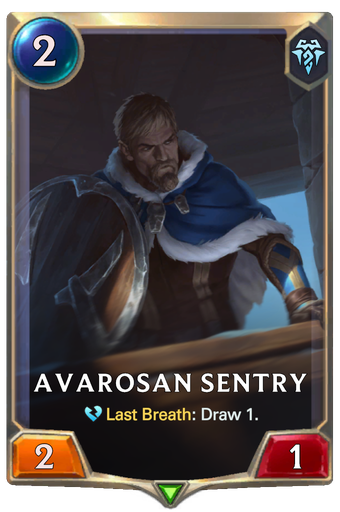
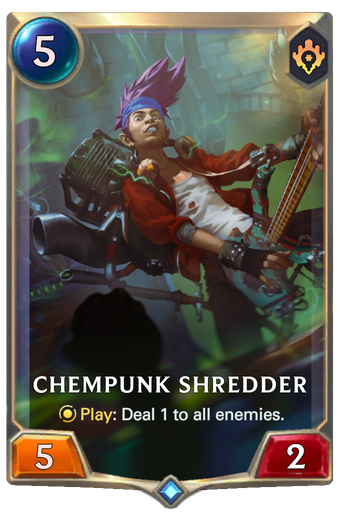
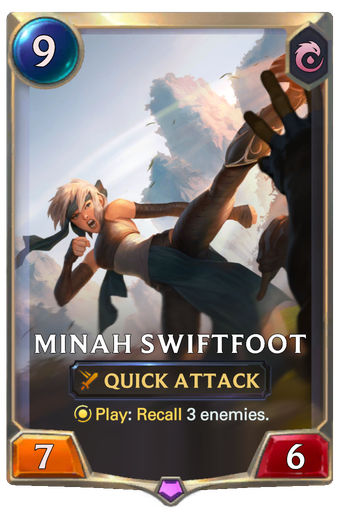
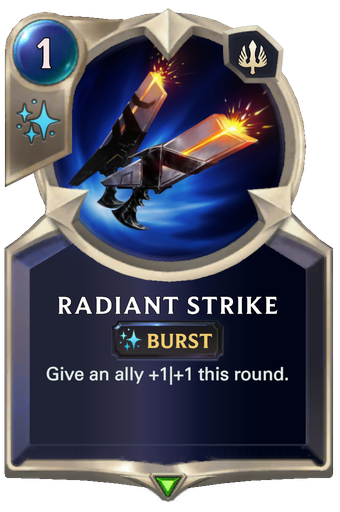
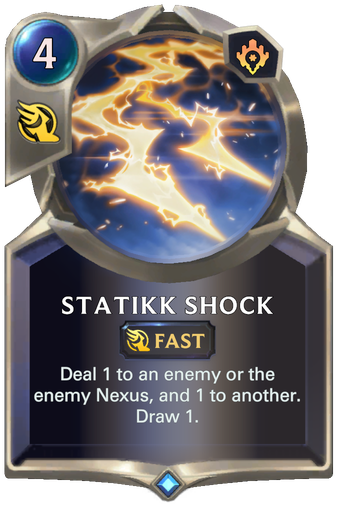
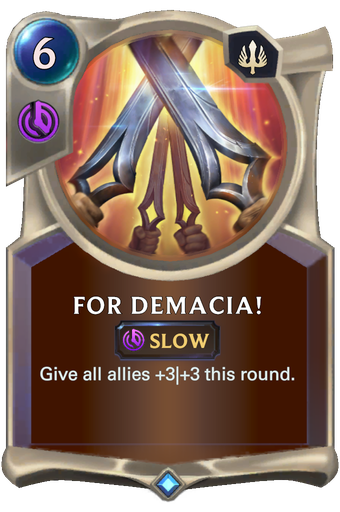



Comments
Just found this article. I think that it should be more visible and sticked in the site. It helps me a lot in my big backpack of doubts that I had whilst playing my first plays in Runeterra. Thanks a lot for it :)
My tiny brain can't handle anymore keywords from all the CCGs I play!
Thank you for this great article. I feel this tingling hype senSATIOn building on my left shoulder and on my right is the devil saying...
So many people saying they wanted a game that had slivers of MtG and Hearthstone and yet there has been one all along. Eternal.
It's a pity that a New and Shiny has taken some light away from an already established game that is extremely F2P friendly and has aspects from both aforementioned CCG's.
Not taking away from Runeterra, it looks amazing. I'd just be cautious. There's plenty of time for Riot to change things around. Don't forget that they want to make money from this. And the hype building up around this game is very reminiscent of Artifact. I know, I know it's a boring comparison already. But its just so similar. Many Streamers saying this is going to be brilliant, a few people who have played saying it's going to destroy Hearthstone, and people hanging onto the Hypetrain as it goes rattling along the tracks.
I hope Runeterra works out. I, like so many of you, would like a game to legitimately challenge Hearthstone's dominance of this particular little corner of the gaming market.
This is just a reminder that there are already some very good and established DCCG's out there.
I'm fully aware that this is probably neither the time or the place for these things to be bought up. But the comparisons are going to be made.
Something I'd really like to see on this site is an article talking about the various games, the player bases, how long matches take, how long match-making takes, card economy etc. I don't want the site to go all-in on ES: Legends, Shadowverse, Faeria, Gwent etc., but it might be nice to find out the status of these games from time to time. I don't know of another site or resource that really compares/contrasts all the MTG/Hearthstone imitators. I remember a few years ago I tried getting into Hex, and it was one of the most inaccessible games I've tried. I know nothing about Eternal, but I'd be curious about its history to date, player-base, etc.
It is a shame that a great card game like Eternal is literally ignored by the mainstream. It's all talk about Hearthstone and MTG:A rising up to compete with it. Heck, even Shadowverse and Gwent get mentioned over Eternal. And Artifact.
That aside, with LoR, it has a lot of good things going for it. F2P economy looks good, at least Riot's philosophy for it. They can leverage their huge League of Legends IP to bring awareness to it. Some of my friends just jump on it as a reason to say that Hearthstone is a dead gaem now. The game can be pretty fun, but I also didn't quite get into it and think up lots of decks, so I was losing to some pretty crazy stuff.
Awesome write up! I'm hoping to get into the next preview and plan to play BOTH card games, personally. How much of one over the other is still to be determined, but I will probably never leave Hearthstone completely due to the investment of both time and money I've put into it (dear God, the money...).
EDIT: I should add that one of the coolest features to me is the way you can decide which factions you earn cards in. Since you don't have random packs in the game, the option to earn xp, have that xp unlock cards, and you get to choose which faction you're trying to level up makes it easier to get all the cards you want if you're only interested in a single play style, or trying to earn cards for a specific deck.
Thanks for the really interesting article! As a HS since beta -player l'm really interested in this and was sad I didn't get the ticket to play yet. Warcraft's universe has been a place where I have grown up and I have never played any Riot's games, but still I can see the huge potential in this! Keep writing, you are good at it!
I was expecting a guide for Hearthstone players, and you didn't fail. Thank you very much!
I hope we get the same experience playing LoR on mobile as HS.
The best part is that I don't even need to change my favourite cards website when playing it :D
Great write up and introduction to the game! Outof.cards is providing an excellent resource for all of us that have not yet had the opportunity to play, and the reviews of the preview have been pretty much all positive! Hopefully it won't change elements before full launch...
This is the first DCCG that has looked as interesting since I started Hearthstone (and it comes at a very opportune time). HS appealed to me because it was free-to-play, has a great fun design and is easy to play but difficult to master. It looks like those elements are present in Legends of Runeterra, plus the ability to create a specific deck with less RNG really calls to me...
That being said...
While I optimistically hope to receive a key for November 14th, I will temper my enthusiasm (and I would recommend everyone do the same) with memories of other titles that have looked phenomenal before launch to fall flat when released. The preview patch helps negate some of those concerns (i.e. we are actually seeing real-time play, not being shown it), but developers often have wonderful, groundbreaking ideas that, for some reason or another, never make it into the game... at least, not in the way we thought. It's great to be excited and looking forward to a game's launch, but it's kind of like declaring Jared Goff the next Tom Brady (for those that watch football).... slow down a bit, and let's wait and see.
I hope it's incredible and changes the landscape of DCCGs, but until LoR releases, I will just remain hopeful and not invested.
So is it worth creating riot account before November 14? I am kinda getting bored of HS
Yes, you can pre-register for November now
Will there be key drops in the next alfa/test phase (november)?
Yes
I got into the early access over the past week, and since blizzards actions recently i think i am going to be switching games to runeterra, that game is imo a nearly perfect card game with all gameplay mechanics, i can't remember having this much fun playing a card game since when i first started hearthstone back in early beta
That's the ONE reason to NOT switch to Runeterra.
I think what MisterFerro means is that LoR is made by Riot, which is owned by Tencent, a Chinese company. Riot also came out in with their own statement not really in support of either party involved, but as a reminder to their players that political statements would not be tolerated because they want to keep personal and political views separate from their games due to serving many different countries and cultures. So in essence, switching to show you are not for China and for a Free Hong Kong might actually be a counter-intuitive move. As a side note, Epic Games made a statement that they would not punish someone for something like Blitzchung's statements. Tencent owns about 40% of Epic, but the majority is still owned by one of the founders.
Yes, Blizzard acted way too quickly and too harshly without considering the backlash. Even if they were only acting according to the rules in the GM agreements and not thinking of their profits from the Chinese market, as they said in their updated statement, there is NO WAY people will believe it because of the speed and severity of the first ruiling. I think if they had first released a statement that he knowingly violated the rules, slapped him with a warning or a three month suspension, this would have all blown over by now.
I'm happy that they gave him back his prize money, and while I still think the 6 month ban is still too long, it's actually a LOT better than the 1 year they originally gave him. I say that because if GM follows the same format next year in terms of dates, etc, he could actually end up missing no time at all in GM as the ban would end before May, and May is when GM started this year.
I will also add, while what you do is up to you, you don't have to completely leave HS unless you're also just really bored with it. You could play both! I personally am thinking of just playing both. And if this matters to you at all... Kibler was still playing HS today on his stream. Just saying! :)
It hasn't even been a day since the preview patch ended and I already can't wait to play in the next one. I like Hearthstone a lot and I've put too much time and money into it to just quit, but if Riot does things right with LoR there is a very real chance that I will end up playing it more than Hearthstone. It also helps that I've been playing LoL since season 2 and I know every single champion and a decent amount of lore, so seeing that come to life in a card game has been great.
I also want to mention that I absolutely LOVE the animations in LoR, especially the champion level ups. Even when I'm losing I can't help but gaze in awe at Garen spinning his giant sword right in my face.
I'm sure these are all compelling reasons to switch over for someone who looks at Hearthstone as only a card game, but this game doesn't hold a candle to the depth I feel in the roots of Heathstone through its story and art. Hearthstone is built on lore that's over 20 years in the making and is featured in games where you get to interact and develop an almost personal connection with the main characters. LoR is based off the lore of a MOBA where any sense of depth or story is irreverent to the actual game. For me, this is akin to selling off an old family antique that you have history with in order to replace it with the new flashy model that a door-to-door salesmen offered you. If you don't see Hearthstone that way, no problem. I'm not judging, although I do think you are missing out. I just want to offer an alternative perspective.
Although I am agreeing some points I need to say that I disagree with the decision part.
You really don't need to decide to play Hearthstone or Runeterra. You can play both of them in my opinion.
Also i need to attach that Hearthstone decided to split the lore of Warcraft long ago which negates your dissertation. What was the E.V.I.L. for example or MSoG or Karazhan or Booms Lab etc. ? Where are real lore related content in Hearthstone ?
I always wanted to see some characters and lore expansions/adventures in Hearthstone but they never did that. They always tried to bring some new lore to the hearthstone.
So it is a fraud in my opinion. They are selling the game as "Heroes of Warcraft" but they are not really bring lore related stuff to the game. Sorry but the "Old Family Antique" never happened in Hearthstone. Blizzard always sold and replaced the "New Flashy Model" in the name of "Old Family Antique" to the players. That what really happens in Hearthstone. Players always thought that they are buying Antiques but never got that.
I am a fan of Blizzard since I played Warcraft 1 and Diablo 1. I played all of the games of them except The Lost Vikings. I am still playing Overwatch, Hots, Hearthstone and Diablo 3. Really love to read Warcraft lore from time to time but we need to qualify the things truly.
As we can see, Noone is playing the Hearthstone because of the Warcraft lore. They are playing the game because it is popular. If it loses its popularity, noone plays it. Because nowadays people doing everything because of its popularity. They can stop doing anything if they think it is not popular anymore. That's the thing.
I have the beta and tried Runeterra. I really liked it because I always want to play a MTG/Hearthstone Hybrid card game. I always thought "I wish there is a game which is MTG/Hearthstone hybrid" and Runeterra is the game what I wished for. Mana, Minion damage and Minion limit system of Hearthstone with Reaction, Combat system of MTG.
I will keep playing Hearthstone also I will never stop playing it. Although I have spent so less money to it, I have almost all cards and I can enjoy it but I will play Runeterra too. It seems it will be f2p friendly. I will decide after the game officially published. If I sense that I can't play it without real money I can decide not to play it but for now, I'm planning to play both games.